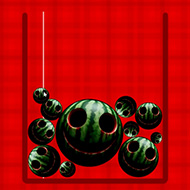

Do Not Grow This Watermelon looks harmless at first. The small fruits dropping into the container seem easy enough to handle. But as soon as they start merging into larger fruits, the challenge reveals itself. Every merge reduces the available space, and the once roomy container begins to feel smaller with every move. This creates tension that builds steadily until the moment the watermelon arrives. At that stage, survival becomes nearly impossible, making the game a battle of foresight and smart positioning. The true challenge lies not in reaching the watermelon, but in delaying it as long as possible.
Mastering the game requires an understanding of the fruit ladder. Each fruit leads into the next, and remembering this order is crucial for strategy. Cherries and strawberries may merge quickly, but as grapes, oranges, and other mid-tier fruits appear, merges become more difficult. Larger fruits are harder to position, and once they land in awkward spots, they can block multiple potential combinations. Eventually, the watermelon emerges as the final stage, which signals that the puzzle is almost lost.
Do Not Grow This Watermelon is simple to pick up but rewards strategic play. Skilled players often rely on the following techniques:
The beauty of the game lies in its replayability. Even with the same rules every round, the random sequence of fruits makes each attempt feel different. Some games run smoothly, while others present chaos right from the start. This unpredictability challenges players to think on their feet, and every small victory feels satisfying. Unlike many puzzle experiences, there’s no final “win” condition here — survival itself is the prize. That’s what makes the pursuit of higher scores so addictive.
Do Not Grow This Watermelon thrives on the balance between control and chaos. It offers enough structure to allow planning, yet enough randomness to ensure no two runs feel alike. That combination keeps the challenge fresh, motivating players to push their limits every time they drop the first fruit.